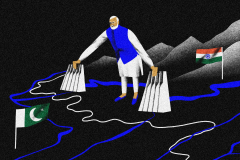Islamabad, Pakistan – Seven decades ago, one of South Asia’s greatest fiction writers, Saadat Hasan Manto, published a short story set in a village in Pakistan’s Punjab province. The plot revolved around rumours of an Indian plan to “shut down” water to Pakistan by closing off rivers that irrigated the province’s crops.
A character in the 1951 story titled Yazid responds to that chatter by saying, “…who can close a river; it’s a river, not a drain.”
That theory is now on test, 74 years later — with implications for two of the world’s most populous nations that are also nuclear-armed neighbours.
In April 2025, after gunmen killed 26 civilians, almost all tourists, in an attack in Indian-administered Kashmir, New Delhi blamed armed groups that it said were backed by Pakistan for the violence.
India announced it was walking out of the Indus Waters Treaty (IWT), a six-decade-old transboundary water agreement that governs the division of water from the Indus Basin’s six rivers. The treaty is a lifeline for more than 270 million people, most of whom live in Pakistan.
A day after India’s announcement, Pakistan’s National Security Committee (NSC), the country’s top security body, rejected the “unilateral” move, warning that “any diversion of Pakistan’s water is to be treated as an act of war”.
In the weeks that followed, India and Pakistan engaged in an intense four-day conflict in May, during which both countries exchanged missile and drone strikes, before US President Donald Trump announced a ceasefire between them.
But though the guns have fallen silent, for now, the neighbours have both launched diplomatic campaigns aimed at convincing the world about their narratives.
And India has refused to reconsider its decision to set aside the IWT. On June 21, Amit Shah, India’s home minister and the man widely considered as the second-in-command to Prime Minister Narendra Modi, declared the treaty would remain suspended permanently.
“It will never be restored. International treaties cannot be annulled unilaterally, but we had the right to put it in abeyance, which we have done,” Shah told The Times of India, the country’s leading newspaper, in an interview.
“The treaty preamble mentions that it was for peace and progress of the two countries, but once that has been violated, there is nothing left to protect,” he said.
For Pakistan, a lower riparian country, even the possibility of water disruption is an existential threat.
Blocking river flows threatens agriculture, food security, and the livelihoods of millions. It could also, warn experts, set the stage for a full-fledged war between India and Pakistan.
So can India really stop Pakistan’s water? And can Pakistan do anything to mitigate that risk?
The short answer: India cannot completely stop the flow of rivers into Pakistan, given the current infrastructure that it has. But experts caution that even a small diversion or blockage could hurt Pakistan, particularly during the winter season. And at the moment, Pakistan does not have the reservoirs it needs to store enough water to deal with the crisis it would face if India were to manage to stop the flow of the Indus Basin rivers.
A river that defines the region
The mighty Indus River, the 12th longest in the world, originates from Mount Kailash in Tibet at an elevation of 5,490 metres (18,000 feet).
It flows northwest, cutting through the scenic yet disputed Kashmir region, before entering Pakistan and travelling some 3,000 kilometres (1,864 miles) south to the Arabian Sea.
In Pakistan’s Khyber Pakhtunkhwa province, the Indus is joined by its western tributaries – the Swat and Kabul Rivers – as it carves through mountainous terrain.
Entering the fertile plains of Punjab, the river’s five eastern tributaries — the Jhelum, Chenab, Ravi, Beas and Sutlej — meet the Indus.
These rivers flow through Indian-administered Kashmir and other Indian states before entering Pakistan.
This geographic dynamic, with India as the upper riparian state and Pakistan the lower state, has fed into long-standing distrust between the neighbours.
To be clear, transboundary water conflicts are not exclusive to Pakistan and India, and historians have recorded wars over water since ancient times.
In the last half a century alone, Turkiye, Syria and Iraq have had disputes over water sharing due to the construction of dams on the Tigris and Euphrates Rivers.
More recently, there is an ongoing water conflict between Egypt and Sudan against Ethiopia, an upper riparian state constructing a dam on the Nile, causing insecurity among the two lower riparian nations.
In South Asia itself, Bangladesh, India and Nepal have water-sharing disputes over the Ganges-Brahmaputra-Meghna rivers system.

Partition’s lingering legacy
As with most India-Pakistan disputes, the two countries’ tensions over water are rooted in the partition of the subcontinent in August 1947, when both nations gained independence from British colonial rule.
The region of Jammu and Kashmir, where the Jhelum originates and the Chenab flows, became a central point of conflict.
But another critical issue was the division of Punjab’s irrigation system, which had operated as a unified network under British rule. Canals, rivers and headworks were all intertwined, complicating water sharing.
A short-lived agreement held until March 1948, when India suspended water flow through two canals into Pakistan. The stoppage left nearly eight percent of cultivable land in Pakistani Punjab without water for five weeks.
That early crisis inspired Manto’s Yazid and served as the catalyst for the Indus Waters Treaty.
With World Bank mediation and financial support, the treaty [PDF] was signed in September 1960, after nine years of negotiations between India and Pakistan.
According to Majed Akhter, senior lecturer in geography at King’s College London, the treaty was a “hydraulic partition” that followed political partition. “It was needed to resolve issues of the operation of an integrated irrigation system in Punjab, a province which the British invested heavily in and that was partitioned in 1947,” he told Al Jazeera.
But Akhter pointed out that water sharing between the neighbours is also linked to their dispute over Kashmir. Both India and Pakistan control parts of the region, with China also administering two slices of Kashmir. India, however, claims all of Kashmir, and Pakistan claims all of the region other than the parts controlled by China, its ally.
“Territorial control of Kashmir means control of the waters of the Indus, which is the main source of water for the heavily agrarian economies” of Pakistan and India, Akhter said.
India and Pakistan have fought three of their four wars over Kashmir, before the latest conflict in May.

Treaty that divided the rivers
The 85-page treaty is unusually structured. Unlike most global water treaties that share water according to their total volume of flows, the IWT divides the rivers.
The three eastern rivers – Ravi, Sutlej, and Beas – were allocated entirely to India, while the three western rivers – Indus, Jhelum, and Chenab – were reserved for Pakistan’s exclusive use.
India, however, was permitted to build “run-of-the-river” hydroelectric projects on the western rivers, provided they adhered to design limitations meant to ensure uninterrupted water flow to Pakistan.
The treaty also has a three-tiered dispute resolution mechanism.
Any technical questions are brought before the Permanent Indus Commission, a standing bilateral body composed of one commissioner from each country, which is set up under the IWT clauses.
If the commission can’t resolve any differences, the matter is then referred to a neutral expert under the supervision of the World Bank. If the dispute still remains unresolved, it can then be taken to the Permanent Court of Arbitration (PCA). The Hague-based PCA is not a United Nations agency but an intergovernmental organisation to which countries go to “facilitate arbitration and other forms of dispute resolution between states”.
Though the treaty has been in place for over six decades, this formal dispute resolution path has only been invoked in three cases, all involving Indian hydroelectric power projects on western rivers: Baglihar, Kishenganga and Ratle.
India was able to win its case regarding Baglihar, a dam built on the Chenab, before a neutral expert in 2007, following which the project started operating a year later.
The Kishenganga project, built on the Jhelum, again faced resistance from Pakistan, which claimed the construction would impact water flow into Pakistan-administered Kashmir.
The matter was taken to the PCA, where a 2013 decision allowed India to divert water for power generation purposes, while ensuring that water flow towards Pakistan continued. The project was inaugurated in 2018 by Indian PM Modi.
The Ratle hydroelectric plant, also being constructed on the Chenab, is the latest flashpoint between the two neighbours.
Pakistan has sought the PCA’s involvement over the dispute, but India has argued that under the IWT, the countries need to first go before a neutral expert. However, with India now no longer adhering to the water-sharing treaty, a cloud hovers over the arbitration process, while construction on the project continues.
‘Blood and water’
Over its 65-year history, the IWT has withstood major pressures: Wars, a secessionist movement in Indian-administered Kashmir, recurring military skirmishes, deadly attacks in India that New Delhi has blamed on Pakistan-backed armed groups, and even nuclear tests by India and Pakistan.
The April 2025 Pahalgam attack marked a breaking point. But signs of the treaty’s fragility had emerged long before that.
In September 2016, following an attack on an Indian Army base in Uri, a town in Indian-administered Kashmir, that killed at least 18 Indian soldiers, India accused the Jaish-e-Muhammad, a Pakistan-based armed group that has carried out multiple attacks on Indian soil, of being behind the Uri strike.
Pakistan swiftly denied any involvement of its government, but India’s then-Home Minister Rajnath Singh branded Pakistan a “terrorist state” that supported “terrorists and terrorism groups”.
Prime Minister Narendra Modi, then in his first term leading the Hindu majoritarian Bharatiya Janata Party, declared, “Blood and water cannot flow at the same time”, amid growing calls within India to stop the flow of water in Pakistan.
Nine years later, after India actually walked out of the treaty, former Pakistani Foreign Minister Bilawal Bhutto Zardari issued a warning even more chilling than Modi’s original comment.
“The Indus is ours and will remain ours, either our water will flow through it, or their blood,” he thundered at an April rally in Sindh, a province named after the Indus River (Sindhu in Sanskrit).

Symbolism or substance?
Several water experts argue that India’s suspension of the IWT is more symbolic than immediately harmful to Pakistan.
Naseer Memon, an Islamabad-based





